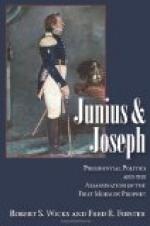One day, when the men were out cutting the maize, Susannah rode with her uncle to the most distant of his fields, and found herself on the hill called in Smith’s revelation Cumorah.
The sound of the men at work and the horses shaking their harness was close in her ears while she strayed over this bit of hilly woodland. It is one of the low ridges that intersect the meadows on the banks of the Canandaigua, and here Smith professed to have found the golden book. It was because of this that Susannah had the curiosity to climb it now.
The beech wood grew thick upon it; the afternoon sun struck its slant sunbeams across their boles. Once, where the beeches parted, she came upon a fairy glade where two or three maples, fading early, had carpeted the ground with a mosaic of gold and red, and were holding up the remainder of their foliage, pink and yellow, in the light. The beauty wrought in her a dreamy receptive mood. Climbing higher, she came upon a very curious dip or hollow in the ground. In its narrowest part a man was lying prostrate; his face was buried in his hat, which was lying upon the ground between his hands; the whole expression of his body was that of attention concentrated upon something within the hat. When she came close he moved with a convulsive start, and she saw that it was Joseph Smith.
His look changed into one of deference and satisfaction. He rose up, lifting his hat carefully; in it lay a curious stone composed of bright crystals, in shape not unlike a child’s foot.
“It’s my peepstone,” he said. “It’s the stone I look into when I pray that I may be shown what to do.” Exactly as one child might show to another some worthless object he deemed choice, he showed the stone to her.
“I don’t know what you mean. How could a stone help you?”




